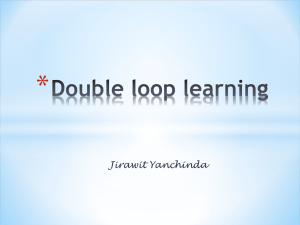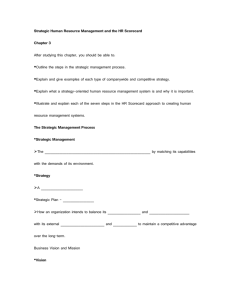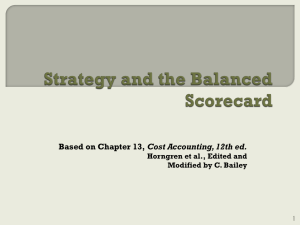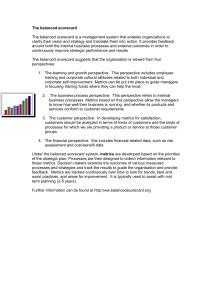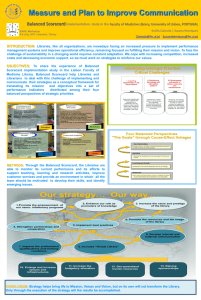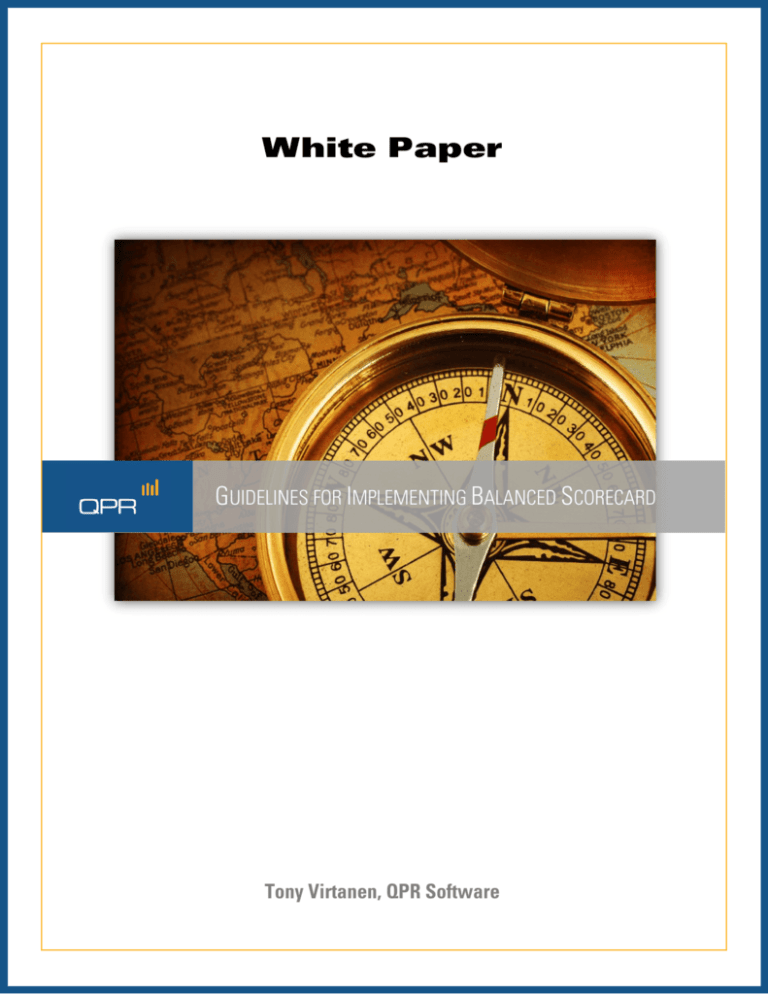
White Paper
GUIDELINES FOR IMPLEMENTING BALANCED SCORECARD
Tony Virtanen, QPR Software
[Type text]
Guidelines for Implementing Balanced Scorecard
2009
Executive Summary
The Balanced Scorecard is a management system that enables
organizations to clarify their vision and strat egy and translate them into
action. When fully deployed, the Balanced Scorecard transforms strategic
planning from an academic exercise into the nerve centre of an enterprise.
A prerequisite for implementing a Balanced Scorecard is a clear
understanding of the organizations vision and strategy. The basis for the
vision and the strategy should be the holistic view and the information the
management receives during systematic strategy w ork.
The implementation of a BSC should alw ays be organized as a separate
management syst em development project. The project should be planned in
the same detail as any other project in the organization and standard
project management procedures should be follow ed. The actual
implementation of a Balanced Scorecard can be divided into five phases:
Model synthesis, t echnical implementation, organizational integration,
technical integration and operation. Many of the above phases can be
performed parallel. This w ill shorten the total project schedule significantly.
During the model synthesis phase the organization seeks consensus about
their vision and strat egy and derive the needed measures. Furt hermore the
strat egy of the organization is quantified into measures or Key Performance
Indicators (KPI' s). The measures can be derived from the strategy using
Critical Success f act ors (CSF' s) or alt ernatively using Strategy maps. The
key properties of each of the measures in a Balanced Scorecard are also
defined.
In the technical implementation phase the visions, strategies, critical
success factors, measures et c. are entered into the system. The technical
implementation steps include; installation of the softw are, training, building
of the scorecards, setting target and alarm levels, setting dat a
consolidation rules as w ell as defining graphs and possible customised
reports.
The objective of the organizational integration of the Balanced Scorecard is
to integrate it w ith the management and reporting processes of t he
organization and communicate t he BSC to all the members of the
organization.
Technical integration is performed to reduce the effort needed to collect
measure data. The Balanced Scorecard system is integrated to operational
2|Page
Confidential and Proprietary • Copyright© QPR Software Plc • All Rights Reserved • www.qpr.com
Guidelines for Implementing Balanced Scorecard
2009
IT systems, dat abases and/or data w arehouses such as financial reporting
systems, Enterprise Resource Planning (ERP) systems or Customer
Relationship Management (CRM) systems.
The benefits from t he Balanced Scorecard are realized w hen the Balanced
Scorecard is used in day-to-day operations. Data update, analysis and
reporting are performed regularly w ithin the management and reporting
processes. From time to time it is also necessary to refine t he Balanced
Scorecard. The Balanced Scorecard should be a standard tool used by the
management team in their strat egy w ork.
Due to the nature of a Balanced Scorecard project exact time & cost
estimat es for the w hole project can be difficult to make in advance. The
needed effort depends very much on how far the organization has
advanced in its Balanced Scorecard thinking as w ell as the complexity and
number of Scorecards implemented. The total costs for a typical Balanced
Scorecard project consist of: Time used by customer' s ow n resources
(50% ), outside process consultancy (20% ), outside implement ation
consultancy (15% ), softw are licenses (15% ).
A fast track approach to implement Balanced Scorecard can be used
successfully w hen implementing Balanced Scorecards w ith organizations
that have already used Balanced Scorecards or to create a f ast pilot
Balance Scorecard implementation.
3|Page
Confidential and Proprietary • Copyright© QPR Software Plc • All Rights Reserved • www.qpr.com
Guidelines for Implementing Balanced Scorecard
2009
Table of Contents
Introduction
5
Prerequisites
5
Planning Your BSC Project
6
Implementation Phases
7
Phase 1: Model Synthesis
7
Phase 2: Technical implementation
9
Phase 3: Organizational Integration
10
Phase 4: Technical Integration
10
Phase 5: Operation of the BSC System
12
Estimating Project Scope and Cost
12
Fast Track Balanced Scorecard Process
13
Appendix I – Implementation Examples
15
Appendix II – Summary of BSC Project Steps and Estimates
16
Next Steps
18
4|Page
Confidential and Proprietary • Copyright© QPR Software Plc • All Rights Reserved • www.qpr.com
Guidelines for Implementing Balanced Scorecard
2009
Introduction
The Balanced Scorecard is a management system (not only a measurement
system) that enables organizations to clarify their vision and strategy and
translate them into action. It provides feedback around both the internal
business processes and external outcomes in order to continuously improve
strategic performance and results. When fully deployed, the Balanced Scorecard
transforms strategic planning from an academic exercise into the nerve centre
of an enterprise.
This document outlines a procedure for implementing a Balanced Scorecard for
organizations with little or no previous experience of Balanced Scorecards. The
emphasis is on the practical and technical implementation of the Balanced
Scorecard System.
A fast track approach is also outlined. This approach can be used when
implementing Balanced Scorecards with organizations that have already used
Balanced Scorecards or to create a fast pilot Balance Scorecard implementation.
Prerequisites
Before an organization can start implementing a Balanced Scorecard it
needs a clear underst anding of its vision and strategy. It is the
management' s responsibility to define a vision, formulate a strategy and set
strat egic goals regardless of a Balanced Scorecard being implemented.
The basis for the vision and the strategy is the holistic view and the
information the management receives during systematic strat egy w ork. The
strat egic principles can seldom be bought from outside consultants,
how ever outside expertise can facilit ate the process of creating them.
Common tools used to help structure the strat egy w ork are; Strategy
Mapping, PEST (Political, Economical, Societ al, Technological) analysis,
SWOT (Strengths-Weaknesses-Opportunities-Threats) analysis, Porter value
chain analysis, Porter Five forces of competition analysis, BCG Matrix
analysis.
5|Page
Confidential and Proprietary • Copyright© QPR Software Plc • All Rights Reserved • www.qpr.com
Guidelines for Implementing Balanced Scorecard
2009
Planning Your BSC Project
The implementation of a BSC should alw ays be organised as a separat e
project. The project is very much a management system development
project, rather than an IT project. Before the actual project starts the
follow ing questions should be answ ered:
What is the goal of the BSC project? What current problem does the
Balanced Scorecard solve? What is the goal stat e?
Who leads the project ? The leader should be at least a member of
the management team of the SBU, w hich scorecard is defined.
Who participates in the project ? In a large organization a member of
the corporate management should be involved in order to align the
SBU scorecard w ith the overall corporate st rat egy. In general
different competences should be represented in the project t eam.
The responsibility for BSC project should not be delegat ed to the
controller(s), business development manager or quality manager. Top
management input and buy-in is crucial for a successful balanced
Scorecard implementation.
Which unit (or units) is the pilot unit? In a small organization a
Balanced Scorecard can be implemented in the w hole organization. In
a larger organization one or a few pilot units should be chosen.
Standard Project planning issues, budget, milestones, risk analysis
How w ill the IT system be rolled out? Hardw are and softw are
allocation? Who is responsible for administering the system?
Responsibility:
The ow ner of the Balanced Scorecard / project manager
Methodology:
Standard project planning
Effort:
Customer: 2-5 days
Consultant: 1 day
Calendar time:
2 w eeks
6|Page
Confidential and Proprietary • Copyright© QPR Software Plc • All Rights Reserved • www.qpr.com
Guidelines for Implementing Balanced Scorecard
2009
Implementation Phases
Several different procedures
describing the building process
of a Balanced Scorecard have
been presented. The procedure
described below is just one of
them and is not necessarily
better
than
any
other
procedure.
Before the organization is
ready to implement a balanced
scorecard a consensus of the
organizations
vision
and
strat egy has to be reached
(see chapter: “ Prerequisites” ).
The actual implementation of a
Balanced Scorecard can be
divided into five phases:
Model synthesis
Technical
implementation
Organizational
integration
Technical integration
Operation
Many of the phases can be performed parallel. This w ill shorten the total
project schedule significantly.
Phase 1: Model Synthesis
During the model synthesis phase the organization seeks consensus about
their vision and strategy and derive the needed measures. The model
synthesis phase consist s of tw o major tasks:
Strategy synthesis (structure synthesis)
Measure synthesis
7|Page
Confidential and Proprietary • Copyright© QPR Software Plc • All Rights Reserved • www.qpr.com
Guidelines for Implementing Balanced Scorecard
2009
Strategy Synthesis
The objective of the strat egy synthesis phase is to form and commit the
management to a consensus view about the organisations vision and
strat egies. It is not unheard of that there exist several different view s of
vision and the strat egic principles w ithin an organisation (this is actually
one problem that Balanced Scorecard addresses). A good w ay of finding
consensus is to conduct interview s w ith the management team. The results
of the interview s can then be concluded into a common view that
everybody can commit to e.g. in a w orkshop environment. In addition the
terminology and the elements used in the BSC as w ell as the structure of
the BSC w ill be decided.
Measure synthesis
During the measure synthesis phase the strategy of the organisation is
quantified into measures or Key Performance Indicators (KPI' s). The
measures can be derived from the strat egy using Critical Success f actors
(CSF' s) or alternatively using Strategy maps. The CSF approach is more
straight forw ard, but lacks the ability to describe the logical cause and
effect relationships betw een the measures in the different perspectives.
The key properties of each of the measures in a Balanced Scorecard are
also defined. Attributes needed to be defined are; measure name, unit,
responsible measure ow ner, time-scale, t arget and alarm levels.
Responsibility:
The ow ner of the Balanced Scorecard / project manager
Methodology:
Process
consultancy,
interview s
Effort:
Strategy synthesis: Customer: 10-200 days
w orkshops,
management
Consultant: 5-100 days
Measure synthesis: Customer: 15-30 days
Consultant: 5-20 days
Calendar time:
Strategy synthesis: 3 – 36 months
Measure synthesis: 1 – 3 months
8|Page
Confidential and Proprietary • Copyright© QPR Software Plc • All Rights Reserved • www.qpr.com
Guidelines for Implementing Balanced Scorecard
2009
Phase 2: Technical Implementation
With a pow erful Balanced Scorecard tool like QPR ScoreCard t he technical
implementation of the Balanced Scorecard starts already during t he Model
Synthesis phase. The Visions, Strategies, Critical Success Factors,
Measures et c. are entered into the system interactively as they are
processed e.g. during a Workshop.
The technical implementation includes the follow ing steps:
Installation of the softw are,
Basic training for the persons building scorecards
Building of the scorecards (KPI' s, ...)
Setting target and alarm levels
Setting calculation formulas to consolidate the data
Defining graphical properties for graphs
If needed follow ing additional steps can be taken:
Importing historical measurement dat a from text file / excel
Creating Reports w ith the QPR Add-In for Microsoft Office
In some cases the customer does most of the technical implement ation.
The implementation consultant then takes a more supportive role.
Responsibility:
Implementation Consultant
Methodology:
Workshops, off -site implementation
Effort:
Installation: Customer:
1 day
Consultant: 1 day
Training:
Customer:
2 days / Pow er User
0.5 days / End User
Consultant: 2 days / 10 Pow er Users
0.5 days / 30 End Users
Implementation:
Customer: 1–3 days / scorecard
Consultant: 2-5 days / scorecard
Custom reporting: Customer: 0.5 days / report
9|Page
Confidential and Proprietary • Copyright© QPR Software Plc • All Rights Reserved • www.qpr.com
Guidelines for Implementing Balanced Scorecard
2009
Consultant: 1 day / report
Calendar time:
1–6 months
Phase 3: Organizational Integration
The balanced scorecard syst em should not be set up running as separat e
process in the organization. The BSC is a management system and should
be tightly integrated to the processes of the organization and
communicated t o all t he members of the organization.
The organizational integration phase includes the follow ing tasks:
Definition of the persons w ho are responsible for measure data and
their empow erment.
Explanation of the objectives of Balanced Scorecard implementation
to the employees.
Re-engineering the management and strat egy process
Re-engineering the reporting process.
The BSC syst em should be used in management processes like " monthly
review " , " quarterly business review " et c. Action plans and Comments are
added as part of the management processes. Usually salary bonuses are
based on some measures included in the BSC syst em
Responsibility:
The ow ner of the Balanced Scorecard / project manager
Methodology:
Process consultancy, process development, w orkshops
Effort:
Customer:
10-50 days
Consultant: 5-20 days
Calendar time:
1 – 12 months
Phase 4: Technical Integration
An effective w ay to reduce the effort needed to collect measure data is to
integrate the Balanced Scorecard system to operational IT systems,
10 | P a g e
Confidential and Proprietary • Copyright© QPR Software Plc • All Rights Reserved • www.qpr.com
Guidelines for Implementing Balanced Scorecard
2009
databases and/or data w arehouses. Typically the dat a for 30% -60% of the
measures in a Balanced Scorecard is collected by 1 -3 different operational
systems such as financial reporting systems, Enterprise Resource Planning
(ERP) systems or Customer Relationship Management (CRM) systems. The
rest usually consists of intangible measures that need to be collect ed
separately e.g. inputted manually.
The scope of the technical integration varies enormously, number of
integrated measures and number of outside systems used being the most
important drivers.
The technical integrat ion steps are the follow ing:
Identification of the imported measures and the source syst ems
Analysis of the database structure and exporting capabilities of the
operative syst ems
Defining the procedure to get measure data from dat a sources
including data identification, modification and scheduling.
Implementation of the link betw een QPR ScoreCard and the operative
systems.
Technical integration can be performed parallel w ith organisational
integration and often partially overlaps the operation phase. Effort and
calendar time needed for this phase are highly dependent on the number
and the complexity of the source syst ems.
Responsibility:
Implementation consultant / customer IT department
Methodology:
On-site and Off-site implementation
Effort:
Analysis & specification: Customer: 5-10 days
Consultant: 5-10 days
Implementation:
Customer: 1-10 days
Consultant: 1-100 days
Calendar time:
1 w eek – 6 months
11 | P a g e
Confidential and Proprietary • Copyright© QPR Software Plc • All Rights Reserved • www.qpr.com
Guidelines for Implementing Balanced Scorecard
2009
Phase 5: Operation of the BSC
System
Defining and building a Balanced Scorecard is a very usef ul learning
experience in itself . The organization receives deeper understanding of
w hat drives its business and the cause and effect relationships betw een the
drivers. Still the real benefits from the Balanced Scorecard are realized
w hen the Balanced Scorecard is a part of t he day-to-day operations.
During the organizational integration phase the Balanced Scorecard is
integrated to the normal management and reporting processes of the
organization. Within these processes follow ing tasks are performed
regularly.
Update measure values
Analyze the Balanced Scorecard results
Report the Balanced Scorecard Results
Refine the Balanced Scorecard model
The Balanced Scorecard should also become a st andard tool used by the
management team in their strat egy w ork.
Responsibility:
Scorecard ow ners
Effort:
Continuously 2h / month / Scorecard
Estimating Project Scope and Cost
Due to the nature of a Balanced Scorecard project exact time & cost
estimat es for the w hole project can be difficult to make in advance. The
needed effort depends very much on how far the organisation has
advanced in its Balanced Scorecard thinking as w ell as the complexity and
number of Scorecards implemented. The estimat es presented above
represent averages for customers w ith little or no previous experience from
Balanced Scorecards. The estimates should be re-evaluat ed separat ely for
each case.
The total costs for a t ypical Balanced Scorecard project consist of:
Time used by customer' s ow n resources (50% )
12 | P a g e
Confidential and Proprietary • Copyright© QPR Software Plc • All Rights Reserved • www.qpr.com
Guidelines for Implementing Balanced Scorecard
2009
Outside process consultancy (20% )
Outside implementation consultancy (15% )
Softw are licenses (15% )
In some cases customers might w ant to take the main responsibility for the
Balanced Scorecard w ork. The consultant' s role is then to train and support
the customer, but not be involved in the actual implementation.
Fast Track Balanced Scorecard
Process
When implementing Balanced Scorecards in organizations that have already
used Balanced Scorecards to some extent , a “ f ast-track” procedure can be
used. The fast track procedure can also be used to creat e a fast pilot
Balance Scorecard implementation for any company familiar w ith
performance measurement. The f ast track procedure follow s the same
principle as the normal procedure, but many of the st ages in the normal
procedure are omitted because they are already done or self -evident.
The fast track procedure has five main st ages/events:
1. Mission, Vision & Strategy review and w orkshop preparation. A meeting
w ith the leadership team w here, the mission, vision, strat egic and
operational plans as w ell as budgets are review ed. Furthermore a strat egy
map is outlined and w orkshop preparations are delegat ed. Workshop
preparations include softw are installations.
2. Development w orkshop. A one-day w orkshop w ith the leadership team
w here the strat egy map is completed, strat egic objectives are identified and
measures are selected and defined. The structure of the Balanced
Scorecard is designed and a first draft of the Scorecard is implemented
w ith QPR Scorecard.
3. Refinement & Consensus building. The draft of the Scorecard is refined
by exposing it to w ider group of people. During short meetings w ith key
interest groups measure definitions are refined, targets set and measures
sources identified. The results are immediat ely implemented into the
Scorecard model in QPR ScoreCard.
4. Finalization and communication w orkshop t o educate and communicate
the Balanced Scorecard a final one-day w orkshop for all interest groups is
held. A plan for ext ending the Scorecard to other units/low er levels is
13 | P a g e
Confidential and Proprietary • Copyright© QPR Software Plc • All Rights Reserved • www.qpr.com
Guidelines for Implementing Balanced Scorecard
2009
creat ed. Integration of the Balanced Scorecard into the strat egy and
reporting processes is planned.
5. Technical integration kick-off Technical integration of the Balanced
Scorecard system t o operational IT systems is kicked of w ith a joint
meeting w ith the customers IT support. Measure dat a source systems are
identified and data t ransfer formats are defined. The customer does the
actual implementation.
Responsibility:
Customer
Methodology:
Workshops, On-site and Off -site implement ation
Effort:
Workshops: Customer: 2 days / participant
Consultant: 2 days
Meetings:
Customer: 4 x 0.5 days / participant
Consultant: 2 days
Implementation:
Customer: 1-10 days
Consultant: 1 days
Calendar time:
1 w eek – 2 months
14 | P a g e
Confidential and Proprietary • Copyright© QPR Software Plc • All Rights Reserved • www.qpr.com
Guidelines for Implementing Balanced Scorecard
2009
Appendix I: Implementation
Examples
1) Small Implementation
Hardw are configuration: 1 Window s Server 2003 – 2008
(Dat abase+ Web server+ AS+ WAS)
Softw are configuration:
1 QPR ScoreCard Application Server (AS)
1 QPR ScoreCard Web Application Server (WAS)
3 QPR ScoreCard Designer - clients
30 QPR ScoreCard Brow ser - clients
Scorecard size:
1 QPR ScoreCard model
2 Consolidation Scorecards
5 Scorecards
200 Measure elements
Users:
3 Developers
5 Pow er Users
25 Normal Users
Dat a Sources:
0-3 Source Dat abases
1-5 Excel Files
Project Estimates:
Model synthesis: Customer: 25 days
Consultant: 10 days
Technical implementation: Customer: 25 days
Consultant: 10 days
Organizational integration: Customer: 10 days
Consultant: 5 days
Technical integration: Customer: 3 days
Consultant: 3 days
15 | P a g e
Confidential and Proprietary • Copyright© QPR Software Plc • All Rights Reserved • www.qpr.com
Guidelines for Implementing Balanced Scorecard
2009
Appendix II Summary of BSC Project
Steps and Estimates
Phase / Step / Task
Customer
effort (days)
Consultant
effort
(days)
Calendar
time
Project planning
2-5
1
2 weeks
Model synthesis
25 – 230
10 – 120
4 – 39 months
Strat egy synthesis
10 – 200
5 – 100
3 – 36 mont hs
15 – 30
5 – 20
1 – 3 months
BSC objectives and scope
Define tasks and resources
Creating roll-out plan
Setting milestones
Outlining the budget
Management int erview s
Synt hesis w orkshop
Measure synthesis
Defining CSFs / strat egy map
Selecting measures
Defining measure properties
1 – 6 months
Technical implementation
Installation of softw are
1
1
Basic training (Pow er users)
2 / User
2 / 10 Users
Basic Training (End Users)
0.5 / User
0.5 / 30
Users
1 – 3 / SC
2 – 5 / SC
Training
Implementation
Defining the Scorecard
hierarchy
16 | P a g e
Confidential and Proprietary • Copyright© QPR Software Plc • All Rights Reserved • www.qpr.com
Guidelines for Implementing Balanced Scorecard
2009
Defining the linked elements
Defining measures
Setting target and alarm levels
Setting consolidation formulas
Setting graph properties
Import. historic. measurem.
data*
Creating customized reports*
0.5 / report
1 / report
Organizational integration
10 – 50
5 – 20
1 – 12 months
10 – 50
5 – 20
1 – 12 months
5 – 10
5 – 10
1 – 10
1 – 100
2
1
Analysis of current processes
Re-engineering of processes
Defining responsibilities
Communication of BSC
Technical integration*
Analysis & specification
Identify int egrat ed measures
Identify source systems
Gathering syst em/data descriptions
Implementation
Defining / mapping measure IDs
Creating Queries
Testing
Operation
2 h / month
Updating measure values
Reporting BSC results
Analyzing result s
Refining Balanced Scorecard model
*
17 | P a g e
Confidential and Proprietary • Copyright© QPR Software Plc • All Rights Reserved • www.qpr.com
Guidelines for Implementing Balanced Scorecard
2009
Next Steps
To learn more about QPR Software’s Balanced Scorecard solution please visit
http://www.qpr.com/balanced-scorecard.html
To learn more about testimonials from organizations that applied the QPR
Balanced Scorecard solutions please visit http://www.qpr.com/cpmcustomers.html
18 | P a g e
Confidential and Proprietary • Copyright© QPR Software Plc • All Rights Reserved • www.qpr.com
Guidelines for Implementing Balanced Scorecard
2009
QPR Software Plc
QPR Software Plc is an international, highly regarded partner for enterprises
and public sector in process development and business performance
improvement. QPR’s mission is to help people and organizations to take control
of their business processes and achieve their goals.
QPR software has been implemented in more than 1,500 organizations across
the globe and is provided in more than 20 languages. QPR was founded in
1991, has its headquarters in Helsinki, Finland and co-operates with an
extensive network of talented partners in over 50 countries worldwide.
QPR Software Plc
Huopalahdentie 24
FI-003350 Helsinki, Finland
www.qpr.com
Tel.
Fax:
+358 290 001 150
+358 290 001 151
QPR Customer Care
Tel: +358 290 001 155
customercare@qpr.com
19 | P a g e
Confidential and Proprietary • Copyright© QPR Software Plc • All Rights Reserved • www.qpr.com






